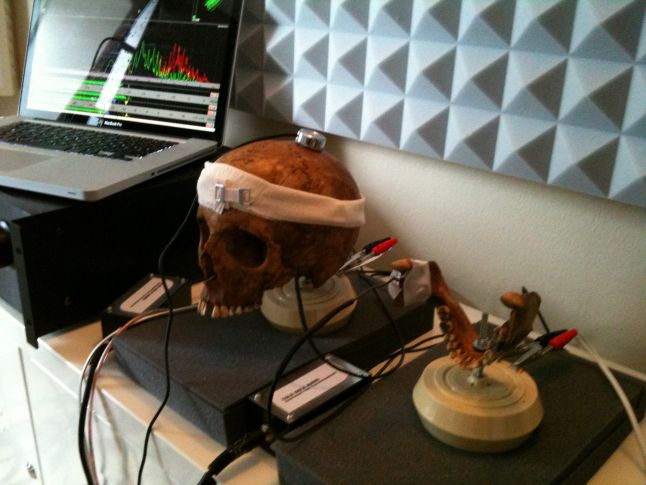
Following his remarkable work on critically acclaimed Limbo, Martin Stig Anderson, Audio Director, Composer and Sound Designer, wanted to raise the bar for the sounds of Playdead’s highly anticipated second title, Inside.
Audio was part of the game development process from the very beginning for Inside, and it played a pivotal role in establishing the game's overall structure and pacing. Largely inspired by 80’s horror movies and synthesized music, Anderson began this creative journey with an eccentric idea; processing synthesized sounds through a human skull. Bone chilling couldn’t be more literal as sounds generating from ‘inside’ this skull express sounds ‘inside’ the gamer’s head. Beyond the existential dark mood, claustrophobic impression, and hypnotic soundscape accentuated with a tense progression within the audio storyline, Anderson focused on creating un-breaking immersion and transcending audio into gameplay. As per Anderson, the world appears to be silent when footsteps are turned up, and these are in fact and quite ironically, his favorite parts of the game "because when this world is naked, you can hear all its details. It’s all in the nuances."
Unbreaking Immersion
Andersen introduces Jakob Schmid, Audio Programmer, and the other members of the audio team behind Inside before describing his vision behind ‘Unbreaking Immersion’, a system offering:
- A natural and adaptable audio playback
- An integration of physical and emotional states
Following his introduction, Anderson jumps right into the game and connects Wwise to solo the character’s ‘Voice’. The character’s ‘Voice’ is composed of breathing and footsteps, and the details and considerations are astounding. This will be explained in details by Schmid, in the next video.
Voice
Schmid presents the “Voice Sequencer” which he scripted in Unity using Wwise’s callbacks that use two modes:
- Continuous mode
- Rhythmic Breathing
A case study on the character’s breathing is presented by Schmid and Anderson. Conceptually, the idea behind the breathing was that it needed to reflect the character’s exhaustion level, movement, environment and emotions, all while ensuring that utmost realism was maintained no matter how the player chooses to manipulate the character. From a Wwise perspective, they used RTPC curves, Switches, States and Side-chaining to make this system dynamic while remaining natural.
Beyond demonstrating how natural the character’s breathing actually sounds, Schmid shares how he took inspiration from DJs and their beat matching techniques and performances. By aligning the frequency and phase of the character’s footsteps and breathing, they would be able to dynamically transform the ambiance of the entire game. Finally, the presentation of the system as implemented in Unity reveals exactly how this was implemented, and it is certainly a source of inspiration for any productions interested in establishing a strong connection between players and characters.
Scene Change
The shockwave scene! Anderson focused on capturing the subconscious of the player via audio triggers and stimuli, however, the shockwave scene is undoubtedly one of the most memorable gameplay realisations. Part of beating the odds with Inside is memorizing and understanding a musical loop which essentially conveys the player’s lifeline. Anderson demonstrates how the game mechanic is attached to a certain rhythm; a lethal shockwave happening every 6 seconds, which forces the player to take cover frequently while opening or closing filters and volume changes within the audio scene. Reverb aux sends are also modulated based on how the player takes cover. Anderson also demonstrates how they used music cues to inform the game when certain graphic effects should be produced to remain synchronized with the audio.
Anderson’s approach was a pure and organic process, and artistically speaking he focused on creating wholeness. "One of the great things about smaller games is that you can play them from beginning to end, just like watching a movie", he says. It was important for Anderson not to follow a strict audio storyline, but rather design a dynamic between local artistic audio expressions while connecting and layering the various elements, authentically.
Audiokinetic would like to thank Playdead and everyone on the Inside team, and particularly Martin Stig Anderson and Jakob Schmid for assembling and presenting this incredible educational presentation and sharing it with the Wwise and interactive audio community. As expected, Wwise Tour presentations represent game audio at its finest, and these series of videos are certainly a must watch! We hope you enjoyed them and that you will want to share them with your fellow game audio peers!


댓글
Tom Todia
October 11, 2016 at 04:09 pm
Wow, that was an amazing blog post! What a creative use of audio.
Nour Hammoud
October 13, 2016 at 03:41 pm
Glad you enjoyed this post Tom! Indeed, such creative use of audio.